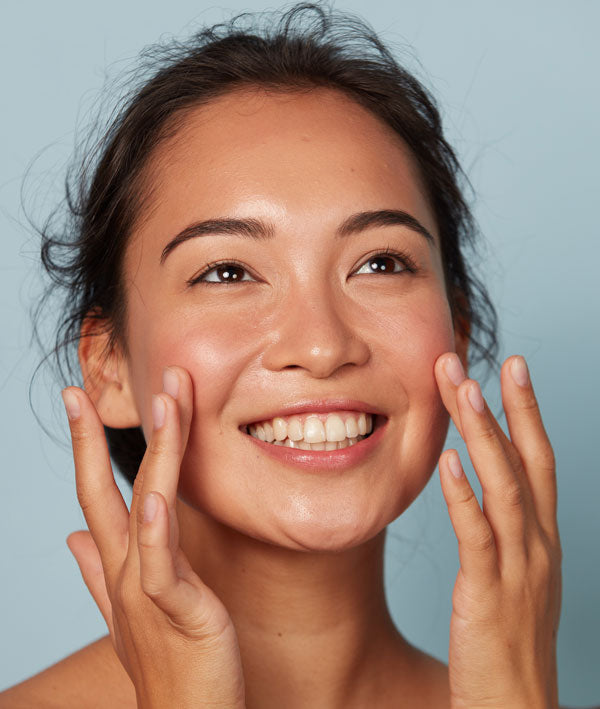Today, we’re doing a deep dive into two high-powered skincare solutions worthy of a spot in your routine: the Hyaluronic Pure Boost and the CoQ10 Boost Serums. These expertly formulated serums support the skin in different ways to promote a healthy, comfortable, and vibrant complexion. Even better, they can easily be used together in the same routine! Here’s everything you need to know.
What is Coenzyme Q10?
Coenzyme Q10 (also known as CoQ10) is a fat-soluble enzyme that’s naturally already present in your body. It plays a key role in energy production in the cells, and helps with their maintenance and growth. The levels of CoQ10 in the body peak when we’re in our teens, and then gradually decline as we age.
While CoQ10 offers a ton of benefits for the complexion, what really makes this enzyme such a powerful skincare ingredient is its antioxidant properties. When applied topically, coenzyme Q10 is able to neutralize free radicals from pollution, UV radiation, and other environmental aggressors in order to protect the skin against their damaging effects.
Top Benefits of Using CoQ10 in Your Skincare Routine
When used regularly, CoQ10 can protect the skin while encouraging a radiant, youthful complexion. Here are the top benefits of using a CoQ10 skincare solution:
In our CoQ10 Boost Serum, coenzyme Q10 is paired with other clean, science-backed ingredients that further support the skin. Glycerin and sodium hyaluronate lock in moisture, while licorice root extract, green tea leaf extract, and vitamin E provide additional antioxidant protection and brightening benefits.
What is Hyaluronic Acid?
Just like coenzyme Q10, hyaluronic acid is naturally found in the body. This molecule lubricates and works as a cushion for tissues in the body, and also helps keep the skin plump and hydrated. Our natural levels of hyaluronic acid deplete as we age, which makes the skin more prone to visible signs of aging.
The many benefits of using hyaluronic acid in skincare largely stem from this ingredient’s impressive hydrating abilities. Hyaluronic is a humectant, which means it attracts and locks in moisture. It’s able to hold almost 1000 times its weight in water, so it’s a powerful remedy for improving hydration levels in the skin.
Top Reasons to Use Hyaluronic Acid in Your Regime
No matter your skin type, you can benefit from using hyaluronic acid. Here’s why you’ll want to add this humectant to your skincare routine:
Our Hyaluronic Pure Boost Serum uses sodium hyaluronate, which is the salt form of hyaluronic acid. This stable ingredient has a lower molecular weight than hyaluronic acid, which means it’s able to penetrate the skin more effectively for maximum effects.
CoQ10 vs. Hyaluronic Acid
One major key benefit that hyaluronic acid and CoQ10 have in common is the ability to target signs of aging. However, they ultimately do so by addressing different root causes.
With its hydrating power, hyaluronic acid is able to plump the skin and support the barrier for a complexion that not only looks more youthful, but also feels softer and more comfortable. CoQ10, on the other hand, uses its antioxidant power to prevent signs of aging while also boosting the production of collagen and elastin.
When used together, these ingredients take a multilayered approach to minimizing and preventing visible signs of aging by targeting varying root causes. They simultaneously target additional skin concerns, such as uneven skin tone, dryness, and a compromised skin barrier.
How to Use Them Together
What’s particularly great about CoQ10 and hyaluronic acid is that they’re both gentle on the skin, and can be used both day and night. Our dermatologist tested and approved serums are also made to be suitable for all skin types, so anyone can safely work them into their routine.
With our serums, we recommend starting with the CoQ10 Boost Serum after cleansing, and then following that with the Hyaluronic Pure Boost Serum. Apply your moisturizer, and then sunscreen during the day.
Alternatively, if you’re not interested in layering serums, you may choose to use one serum in the morning and the other at night. Since both serums are non-irritating and play well with virtually all other active ingredients (such as retinol, chemical exfoliants, and vitamin C), you can easily work them into an already established skincare routine.
When used together on a consistent basis, these two serums will work to promote a hydrated, youthful, and even complexion that’s protected against the damaging effects of free radicals.







